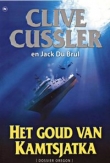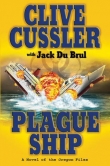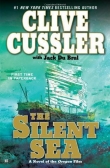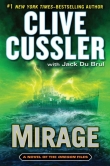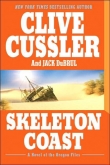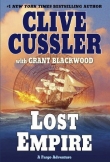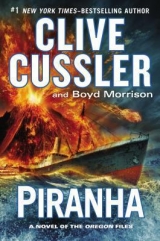
Текст книги "Piranha"
Автор книги: Clive Cussler
Жанр:
Политические детективы
сообщить о нарушении
Текущая страница: 13 (всего у книги 25 страниц)

Maria Sandoval was nearly done with her daily inspection of the Ciudad Bolívar’s vehicle decks. As the master of the ship, her responsibility was to make sure her cargo arrived safely, so she regularly checked the condition of the interior to make sure there were no leaks in the fully enclosed decks that could allow salt water to damage the shipment and to verify that everything remained in its proper place.
The Ciudad Bolívar was the pride of the Cabimas fleet. At 700 feet long and eleven stories high, she could transport up to five thousand cars, primarily serving the growing South American market. Her current load had significantly fewer vehicles because the ceiling of deck 10 had been hoisted to accommodate large construction equipment—graders, backhoes, mobile cranes, dump trucks, bulldozers—all destined for Brazil. The deck below this one was dedicated to cars and SUVs bound for Venezuela and Argentina.
The total value of her shipment was over one hundred and fifty million dollars, and Maria took her responsibility for its care seriously. Her short dark hair and round face made her look younger than her thirty-eight years, and burly new crew members tended to underestimate her when she met them, in her nondescript trousers and unrevealing light sweater. She ran a tight ship, for her first command, driven by the pressure to succeed as the company’s only female captain. With the loss of three Cabimas vessels in the last three months, the crew was edgy, and Maria had spent plenty of restless nights worried about her ship, so she was especially attuned to anything that might pose a hazard.
The construction vehicles stretched out in long rows, parked side by side with inches to spare, maximizing the usable capacity in the cavernous, well-lit interior. Maria was the sole occupant of the hold. Even with the vibration of the ship’s engines and the rumble of the air-handling system, the lack of any other sound in the gigantic space was eerie.
She tested the tie-downs on random vehicles, which had been driven into place on the roll on/roll off ship. She knew her men inspected them on a periodic basis, but she liked to go over their work to ensure that their reports were accurate. If any vehicle came loose in heavy seas, particularly ones like these that weighed upward of fifty tons, it could wreak major damage on the cargo or start a fire.
While the smaller vehicles were secured with canvas straps, those for construction were cinched down with heavy steel chains. Nothing short of a Category 5 hurricane would be able to budge them, and the forecast called for smooth sailing until they reached Puerto Cabello.
Maria finished her assessment and was pleased with the results. She expected a lot from her crew and they never let her down.
She was walking toward the stairs to the bridge when she heard a grinding sound. But it wasn’t coming from the engine. It seemed to be emanating from the hull itself.
Before she could move, the shipwide klaxon shrieked, causing her to instinctively cringe. Instead of short bursts indicating fire, the horn sounded in lengthy peals.
There was a hull breach. The ship was taking on water.
The list would have been imperceptible to anyone not as familiar with the ship as she was, but Maria could feel the slightest tilt to port. She raced to the stairs, pulling the walkie-talkie from her waistband.
“Jorge!” she yelled over the wail of the klaxon echoing in the stairwell. “Report!”
She pressed it to her ear and could tell that Jorge, her executive officer, was responding, but the klaxon drowned out the words.
“All stop!” she shouted, and didn’t listen for an answer.
Maria sprinted up the ten flights and flung the bridge door open, panting from the exertion as she entered. The ship was slowing, the controls set to stop as she’d ordered. Three men were on the bridge: Jorge; the navigator, Miguel; and the helmsman, Roberto. They were moving efficiently, no panic evident, but stress oozed from their pores.
Jorge, a balding man ten years her senior with a potbelly and a goatee, looked at her in utter confusion.
“What did we hit?” Maria asked.
“Nothing, Captain,” he said. “There aren’t any other ships in visual range, and the depth is steady at over two miles. We couldn’t possibly have hit a reef.”
“Rogue storage container?”
“Not likely.”
“How big is the breach?”
“Breaches. We have compartments flooded in eight different locations of the ship.”
“What?”
Jorge showed her the plot of the breaches. They seemed to be concentrated on the port side.
“Did anyone see what happened?”
“A crewman who saw a breach in the bow compartment said it was six inches in diameter and looked as if it had been bored with a drill.”
Maria was astonished. That simply wasn’t possible. A single large gash she could understand. But eight smaller holes opening in a double-hulled vessel was unprecedented.
“Was he able to patch the hole?” she asked.
“No, ma’am. The pressure was too great. He had to seal off the room. I’ve also shut the watertight doors to the engine room. We got major flooding in some of the holds before we were able to seal off the rest of the damaged compartments, but those closed-off areas are still filling with water.”
The ship’s list was at ten degrees and accelerating. Maria was already having to support herself with the console. If they did nothing, the Ciudad Bolívar would reach a literal tipping point. Once it did, it would capsize and sink in minutes.
They couldn’t plug the holes, but they might be able to balance the ship enough to keep it from flipping over. The ballast tanks were already full, so they couldn’t add water to the starboard side to equalize the vessel.
Maria knew she had to find a way to arrest the list. Like all other car carrier captains, she had heard the story of the Cougar Ace, an auto transport vessel like hers that nearly capsized when the captain was cycling the ballast water before entering U.S. waters off Alaska to avoid contaminating American shores with nonnative foreign species. A malfunction during the transfer sequence caused the Cougar Ace to keel over, but not so far that she completely capsized. It took the valiant efforts of a salvage team to right her again after thirty days on her side.
Unlike container vessels where most of the stowage is on open decks, a car carrier is fully enclosed. No other type of cargo ship could have survived turning on its side because at such an extreme list the lower outside decks would have let water into the hull.
Ever since the Cougar Ace accident, most large ships, including the Ciudad Bolívar, had been equipped with a load monitor computer application that helped her crew determine how to arrange the vehicles in the vessel for optimum stability. It also made sure that transferring ballast water was done as safely as possible.
Emptying the ballast tanks on the Cougar Ace had caused the accident, but perhaps Maria could save her ship with the same tactic.
“Miguel,” she said, “send out a distress call. Jorge, input the flooded spaces into the load monitor.”
“Why?”
“Because I want to know which portside ballast tanks to drain.” When he looked at her like she was crazy, she prodded: “Hurry.” The list was now fifteen degrees.
“Aye, Captain.”
While Miguel transmitted the distress call, Jorge’s fingers flew across the keyboard. Two minutes and another five degrees of list later, he said, “Ballast tanks three and four are our best hope. But if the numbers are wrong, we won’t have time to abandon ship.”
As much as the cargo was her responsibility, the crew was an even higher priority.
“Jorge,” she said, “take Roberto and Miguel to gather the rest of the men at the muster station and prepare to launch the lifeboat.” Since it was on the port side and closer to the water, they should still have time to lower it. At least there was no danger of dying from exposure in the tropical climate.
“We’re staying, Captain,” Jorge said. Miguel and Roberto nodded in agreement.
“No, you’re not. It only takes one of us to do this. If it works and the ship is righted, I can bring you back aboard. But if it capsizes, there’s no reason for us all to go down.”
“Just you?”
“It’s my ship. Now, go take care of the men. Let me know when you’re away.”
Jorge swallowed hard, but he could see that further objection was useless. With forced smiles and good luck wishes, the three of them scrabbled out, holding on to anything they could as they walked on the inclined deck.
By the time the crew had reached safety, she might not be able to hold herself upright or even climb out of the bridge. She wasn’t suicidal or excited about a hero’s death. She wanted to survive if at all possible. If things went wrong, she wanted a backup plan.
Maria went outside the bridge to the wall-mounted fire hose. She opened the case and pulled the hose out, unreeling it so that the nozzle snaked into the bridge and slid all the way to the other side. When it was completely unreeled, she went back in to the computer terminal and looped the hose around her waist.
Two minutes later, Jorge radioed that the lifeboat was launched and all crewmen were accounted for. They were motoring to a safe distance, ready to pick her up if she decided to leap from the ship. She thanked him and told him he’d know her choice when he saw what happened to the ship.
The list was now forty degrees, and the hose cut into her hip as the tilt threatened to make her lose her footing. If her plan worked, it would save the ship. If not, the new imbalance might turn it over before she had a chance to escape.
A faithful Catholic, Maria crossed herself and kissed her crucifix pendant. Then she pressed the command to empty ballast tanks 3 and 4, praying that the pumps were still working.
The immediate impact was anticlimactic. No sudden movement, no noise of machinery winding into action. But the screen indicated that the pumps were functioning. The levels of tanks 3 and 4 were declining.
A jolt rocked the ship, increasing its list by ten degrees in seconds, and Maria feared that she had made the wrong choice. Her last order would be the one that killed her and sunk the ship.
The soles of her shoes finally lost their grip and Maria’s feet flew out from under her. Her shoulder smacked into the rubber-coated floor. The hose was the only thing that kept her from tumbling out the door and over the railing, spiraling to the metal deck below.
Like a climber rappelling down a cliff, Maria planted her feet against the floor and gripped the hose with both hands. She needed to get up to where it was attached to the exterior wall before the angle of ascent wouldn’t allow her to use her legs to support her. She was strong, but her arms weren’t muscular enough to pull herself up by her hands alone.
It was a race between her and the ship’s tilt. She clambered up, making sure she had one hand on the hose at all times. One slip and she could smash her head against any of the consoles.
She was halfway up when the hose knocked against the radio on her belt. Before she could grab it, the walkie-talkie detached and tumbled gracefully through the air until it shattered against the railing, a fitting demonstration of what would happen to Maria if she followed it.
With renewed vigor, she climbed the final steps and hauled herself out onto the exterior metal wall of the bridge. She lay back and sucked in deep breaths, exhausted from the effort. It was only then that she realized the list had stabilized. Although the ship wasn’t righting itself, it wasn’t in imminent danger of turning turtle, either.
Maria estimated that the list was seventy degrees, making the whitewashed walls temporary floors. She untied herself from the hose, stood, and walked along the exterior of the crew’s living area situated atop the ship, careful to avoid stepping on the windows. There was no point in going back inside the bridge and trying to adjust the ballast tanks further in the hopes of righting the ship. She could just as easily capsize it. Better to let an expert salvage company do the job.
Maria shielded her eyes from the sun blazing above the western horizon. It would be dark in a few hours and she had to decide whether it would be possible to descend to the port side safely so that she could join her crew. She could open doors into the interior, but navigating the upturned hallways would be riskier than it was worth. She’d wait out on deck until a rescue ship could arrive. Unless there was a naval vessel within range, the ship was too far from any shore for a helicopter to lift her to safety.
She put her hand over her eyes and surveyed the sea until she spotted the lifeboat coming around the aft end of the Ciudad Bolívar. Maria could only imagine the view the crew had of the green hull cocked at such an unnatural angle, the single propeller hovering above the water and the red underbelly exposed for the first time since dry dock.
She waved both arms madly until she saw the men waving back. Their cheers carried to her over the water. When they approached as close as they dared, she shouted down to them that she had lost her radio and would stay on the deck until help arrived. As long as an unexpected squall didn’t develop, camping out under the stars wouldn’t be so bad, given the circumstances.
An hour went by. She lay down and took a siesta, during which she puzzled over the damage that had nearly sunk her ship. She couldn’t think of any phenomenon—natural or man-made—that would cause circular holes to be gouged in the ship’s hull.
Her thoughts were interrupted by the distant sound of an engine. She sat bolt upright and scanned the horizon for a vessel. Then she saw it coming toward them from the east, a gunmetal gray boat eighty feet in length. Too small for a cargo ship, but not the configuration of a pleasure yacht, either. Then she recognized it as an ancient fishing trawler.
It must have been in the vicinity and heard their distress calls. Jorge was probably on the radio with them now. As it approached, Maria was already thinking of ways that they could string up a belaying rope to lower her down.
She waved as it slowed and came alongside the lifeboat, but she couldn’t see anyone on board. Her crewmen crowded along the open weather hatch, waving and shouting joyful greetings.
The door of the trawler banged open and eight men rushed out, all with black objects in their hands. Her crewmen’s shouts of joy changed to cries of terror. She was baffled until she heard the unmistakable sound of automatic gunshots. Maria stood there, shocked into horrified silence, as muzzles flashed and her men were torn apart by the withering fire. It was over in seconds.
One of the men tossed two objects into the lifeboat and closed the hatch. Two thumps followed, and soon flames were consuming the boat. It would sink in minutes, taking her crewmen to the bottom and leaving no trace.
Maria was so horrifically mesmerized by the burning lifeboat that she wasn’t paying attention to the fishing trawler. Someone on board must have spotted her because bullets began to ping off the metal around her.
Without thinking, she ran, dodging rounds, in a desperate attempt to make it to the nearest door. The bullets were getting so close that she realized she wouldn’t have time to open it and climb inside before she was hit. She needed faster cover.
Maria leaped at the next window and braced her legs as she smashed its glass with her feet and plunged through.

Lieutenant Pablo Dominguez pulled himself up toward the bridge by a fire hose that conveniently swayed from its open door. If Admiral Ruiz found out that the Ciudad Bolívar was not sunk, it wouldn’t matter if Dominguez got away from the scene of the crime. He’d already failed her once and had been given a second chance to make amends by overseeing this mission. If he failed again, he would be a dead man.
The hails from an approaching helicopter had been an unwelcome surprise. He certainly hadn’t expected one so far from land. It had to mean that a ship was closing on their position, which was why he’d taken the risk of climbing onto the car carrier to find a way to sink it before rescue arrived.
The Piranha sub design had been purchased from a source of Admiral Ruiz, a man Dominguez knew only as the Doctor. He had been part of a top secret U.S. drone program and somehow smuggled the designs away from the Americans. With the Doctor’s expertise, Ruiz had eight of the miniature submarines built.
They were a stealth design, powered by battery-powered impellers that were virtually silent, so a swarm of subs could creep up on a ship without being detected. Once the subs were within range of the target and had spaced themselves out to maximum effect, they moved in and attached themselves to the ship’s hull with powerful magnets and activated their only weapon: a rotating jet that fired a millimeter-wide stream of seawater pressurized to eighty thousand pounds per square inch. Industrial water lasers are used to cut aluminum, marble, and granite without the scorching of a cutting torch or the ripping of a saw. The Piranha’s compact version used seawater itself as its cutting tool and could slice through the inch-thick steel of a ship’s double hulls in seconds. The simultaneous hull breaches caused by the swarm of subs meant ships would go under before they even knew they’d been attacked.
Though effective, the Piranhas had drawbacks. Because they depended on battery power, their range and duration were extremely short. They could be used only once before they needed a full recharge. The fishing trawler had been specially outfitted to carry and charge the eight-foot-long drone subs. The trawler would place the subs in the path of the freighter to be attacked and leave them there to loiter until the ship was spotted by the subs’ onboard cameras. The trawler, having retreated to a position miles away, would be nowhere near the scene of the crime when the ship went down. Dominguez controlled the subs from his handheld tablet, which allowed him to lock onto the target vessel. The subs would intercept the ship, sink it, and the trawler would recover the subs and eliminate any survivors.
The first three attacks went flawlessly. Each ship went down before lifeboats could be launched, and all Dominguez’s men had to do was get rid of the few crewmen who’d made it overboard. But somehow Captain Maria Sandoval had arrested the capsizing of her ship. The Piranha subs were now recharging, but it would be another thirty minutes before they could be used again. If the rescue ship arrived before then, its crew might be able to save the Ciudad Bolívar, and Dominguez could not let that happen.
He knew he couldn’t wait for the subs to charge. He had to find another way to sink the ship, which was why he was climbing toward the bridge. He’d considered setting fire to the ship, but the onboard CO2 fire suppression system would extinguish the flames quickly. Besides, he had a more elegant solution. An experienced sailor himself, Dominguez knew that emptying the port ballast tanks should cause the ship to flip over.
He could have emptied the starboard ballast tanks, but the ship was already listing so far over that it might capsize before he had time to get back to the trawler. Instead, he would set the port tanks to drain in a trickle, giving him and the trawler plenty of time to get to safety.
He reached the bridge and pulled himself up to the computer terminal. He found the ballast tank controls and configured the port tanks to empty. When they did, the high side of the ship would weigh far more than the side in the water. It would roll back onto its keel and then keep on going, flipping over completely. When it did, water would flood into the hold through the air vents. As soon as the loading doors were compromised by the growing internal pressure, the ship would rocket to the ocean floor.
Dominguez smiled at his clever backup plan. Surely he would receive a commendation from the admiral for salvaging the mission.
After he activated the draining procedure, he drew his pistol and fired at each terminal until every one of them was destroyed. Now no one would be able to shut down the draining from here. The engineering station in the engine room was the only other location where the ballast tanks could be controlled. Once the list became less pronounced and the stairs became usable, he planned to send a man there to shoot up those controls in case Maria Sandoval hadn’t been killed by their gunfire.
Dominguez cursed under his breath as the sound of the helicopter became a roar. The rescuers had arrived sooner than he’d expected.
–
Riding in the front seat of the Oregon’s MD 520N helicopter, Juan couldn’t help but gawk at a sight he’d never before seen. The distress call had prepared him for the Ciudad Bolívar to be capsized, but he didn’t expect the ship to be lying on its side, its keel facing them as they approached from the north. The shipping company’s name, CABIMAS, was spelled out in huge gold letters against a forest green background along the ship’s starboard side. The spectacle brought to mind the Costa Concordia cruise ship resting upon the rocks that had ripped through its hull, but this sight was even more incredible because the car carrier was floating motionless on the open ocean.
“That’s not something you see every day,” Gomez Adams said as he nudged the nose of the chopper down.
“At least we won’t need the welding equipment,” Eddie said from the back, flanked on either side by Linc and MacD. A few months before, they’d come upon a completely capsized mega-yacht whose hull they had to cut into to save the passengers. They were ready to do the same with the car carrier, but the acetylene tank wouldn’t be necessary now that they could see the ship’s interior was accessible. The coils of nylon rope, however, might still come in handy.
The Oregon was behind them and approaching at top speed, but it would be thirty minutes before it arrived.
“Do you think you can land?” Juan asked Gomez.
“I can get the skids in contact with the hull so you won’t have to rope down, but I can’t see anything flat enough to keep us stable.”
“How long can you loiter?”
“I can stick around until the Oregon gets here.”
The Oregon’s helicopter, which was stowed in the aftmost hold, could be raised and lowered on an elevator platform for launch and recovery. The MD 520N was an unusual design because it lacked a tail rotor. Instead, exhaust vented from the turbine was used to turn the chopper and maintain rotational stability. It was so maneuverable that Gomez boasted he could outfly a hummingbird. He was a skilled enough pilot that Juan almost believed him.
They had launched the helicopter as soon as they’d received the distress call. The Oregon had been steaming south from Jamaica ever since Juan had realized the Ciudad Bolívar was in danger. Repeated calls to the shipping company warning them of the impending danger were met with wariness about their motives, and Juan couldn’t blame them. Without a more concrete analysis of the threat, all the company could do was issue a vague caution to the ship’s captain. By the time they were within range to radio the ship directly, the distress call was already being broadcast. When the Maydays abruptly ceased, no ship besides the Oregon was within five hours of the Ciudad Bolívar.
Juan had ordered the helicopter launched so they could get to the ship as fast as possible. Despite repeatedly hailing the ship during their flight, there had been no response. Although they didn’t know if piracy factored into the equation, the fact that there hadn’t been any survivors in the previous sinkings made Juan cautious. All four of the landing party were armed, and Juan had donned his combat leg.
“Let’s find out where the lifeboat is before we set down,” Juan said. “It couldn’t have gone far.” The unspoken concern was that if the lifeboat had launched, they should have heard from someone on its radio by now.
“I’ll give us a good look all around her,” Gomez said.
He came in low, and details of the hull were now visible. The stern and starboard vehicle loading ramps seemed intact and in place. Juan examined the bottom, and his eyes settled on a six-inch-diameter hole in the red paint just above the waterline near the bow. It was the only obvious damage.
“Looks like they’ve got a gopher problem,” Linc said.
“Or someone was drilling for oil in the bottom of the ship,” MacD suggested.
Juan was the most experienced sailor on the chopper, but he couldn’t come up with anything more realistic than their jokes. “Get some pictures of that, Linc.”
Gomez paused for the snaps and then continued back and around the stern. It was only after they reached the port side that they saw a fishing trawler nestled against the car carrier near the bridge at the bow end.
Juan was surprised to see a boat, given the lack of a response to their hails. There was no sign of the lifeboat, but it could be under the water still attached to its davits. Juan’s first thought was that the fishing trawler had come alongside to take the crew off, but as Gomez edged closer Juan knew that was the wrong conclusion.
Cables snaked into the water next to the trawler, eight of them, connected to objects floating on the surface, but Juan couldn’t make out what they were. Ten men stood on the trawler’s deck. One of them was belaying another, who gripped a rope on the ship’s canted deck. Instead of a crewman dressed in work clothes disembarking the ship, the man was clad in black and scaling the rope toward the bridge.
As Gomez got closer, Juan could see that the man on the ship had an automatic weapon slung across his back and was balancing himself on a railing. He was facing the helicopter and speaking into a headset microphone. Juan recognized him instantly.
It was Lieutenant Dominguez from the warehouse in Venezuela.
“Those don’t look like rescuers to me,” Eddie said.
As if in response to Eddie’s observation, the men on the trawler snatched up their own assault rifles and opened fire. Rounds pocked the helicopter’s fuselage before Gomez was able to swing the chopper over the car carrier and out of view.
Juan checked the backseat. “Anyone hit?”
“We’re fine,” Eddie replied for them.
“That was the Navy lieutenant we tied up in Venezuela,” Juan told Linc.
“I know. I think he recognized me.”
“If they’re trying to sink her,” MacD said, “why is he climbing on board?”
“Their original plan must not have worked,” Juan said. “Our hails spooked Dominguez because he didn’t expect to see anyone out here. He could be looking for another way to send her to the bottom and get rid of the evidence.”
“And witnesses,” Linc added. “There could be crew still on board.”
Gomez tapped the gas gauge. “We’ve got a new problem, Chairman. One of the rounds hit our gas tank. We’re losing fuel. What do you want me to do?”
“Can you make it back to the Oregon?”
“I think so, but I’ll have to leave right now.”
“Is everyone up for an excursion?” Juan asked.
“Seems wrong to come all this way and turn tail,” Linc said. Eddie and MacD nodded solemnly. They knew what they were signing up for.
“All right. Gomez, put us down on the stern right behind the funnel to give us some cover. Once they know we’re on board, Dominguez will bring as many men as he can with him onto the ship. They’ll probably post some men on the deck, so we’ll have to go through the interior to get to the bow.”
Gomez hovered over the fantail, making sure to keep the funnel between him and the trawler. He gently rested the helicopter’s skids on the ship’s railing, and MacD popped open the door, climbing down to the railing in one fluid move. Eddie tossed him several loops of rope and then he and Linc followed just as gracefully.
Before Juan could exit, Gomez said, “Take my life raft.”
“You’ll need it if you can’t make it back to the Oregon,” Juan replied.
“You’ll need it if they sink this ship.”
“No we won’t. If this ship goes down, Dominguez isn’t going to leave behind survivors. This mission is all or nothing. See you soon.”
Without waiting for an argument, Juan took off his headset, climbed out, and slammed the door behind him. By the time he reached the nearest hatch to join the others, the helicopter was beating a hasty retreat toward the northern horizon.


